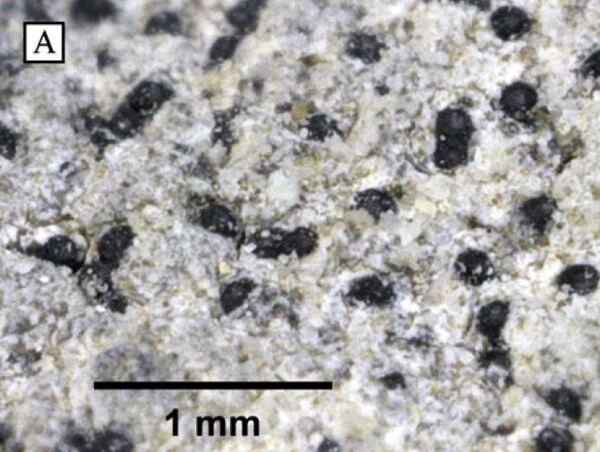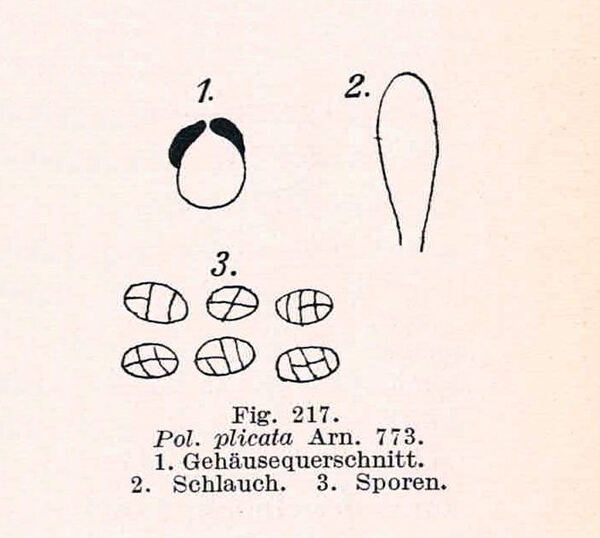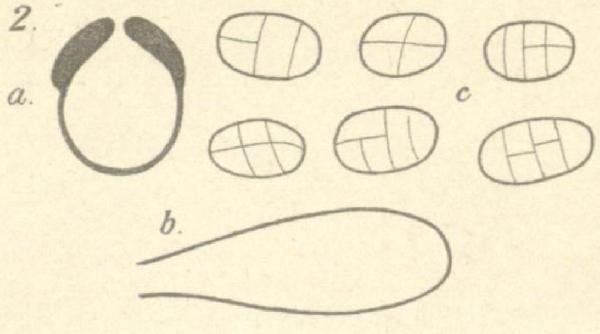Polyblastia plicata (A. Massal.) Lönnr.
Flora, 41: 631, 1858. Basionym: Verrucaria plicata A. Massal. - Lotos, 6: 80, 1856.
Synonyms:
Distribution: N - Ven, TAA, Piem (Isocrono & al. 2004).
Description: Thallus crustose, episubstratic, rather thick, usually rimose-areolate, whitish, grey-brown or ochraceous, sometimes delimited by a black prothallus. Hyphae of the algal layer oriented vertically. Perithecia black, numerous, largely immersed in the thallus, 0.18-0.25 mm across. Involucrellum well-developed around the ostiole to dimidiate, 19-28 μm thick, clearly distinct from exciple except in the ostiolar region, shield-like, spreading almost horizontally; exciple pale brown throughout, merged with the involucrellum in the uppermost part, pseudoparenchymatous; hamathecium of periphyses and periphysoids, interascal filaments absent; periphysoids 16-23 μm long and 1.5-2 μm thick, sparingly branched in the uppermost part; hymenial gel I+ red, K/I+ blue. Asci 8-spored, clavate, K/I-, fissitunicate, the wall thickened above, with a broad ocular chamber, dehiscent by extrusion of an endotunica to form a delicate rostrum. Ascospores submuriform, partly crosswise septate with 1-3 transverse septa and 1 longitudinal septum in the central part of the spore, with 4-8 cells in optical view, hyaline, ellipsoid, but wider towards one end, 11-15(-17) x (5.5-)7-9(-10) μm. Photobiont chlorococcoid. Spot tests: K-, C-, KC-, P-, UV-. Chemistry: without lichen substances.Note: on compact limestone and dolomite in shaded and humid situations, mostly in upland areas.
Growth form: Crustose endolithic
Substrata: rocks
Photobiont: green algae other than Trentepohlia
Reproductive strategy: mainly sexual
Commonnes-rarity: (info)
Alpine belt: rare
Subalpine belt: very rare
Oromediterranean belt: absent
Montane belt: extremely rare
Submediterranean belt: absent
Padanian area: absent
Humid submediterranean belt: absent
Humid mediterranean belt: absent
Dry mediterranean belt: absent

Predictive model

Source: Sanja Savic & Leif Tibell. 2012. Polyblastia in Northern Europe and the adjacent Arctic. Symb. Bot. Upsal. 36,1.
Growth form: Crustose endolithic
Substrata: rocks
Photobiont: green algae other than Trentepohlia
Reproductive strategy: mainly sexual
Commonnes-rarity: (info)
Alpine belt: rare
Subalpine belt: very rare
Oromediterranean belt: absent
Montane belt: extremely rare
Submediterranean belt: absent
Padanian area: absent
Humid submediterranean belt: absent
Humid mediterranean belt: absent
Dry mediterranean belt: absent

Predictive model

 INDEX FUNGORUM
INDEX FUNGORUM
 GBIF
GBIF
 DOLICHENS
DOLICHENS



